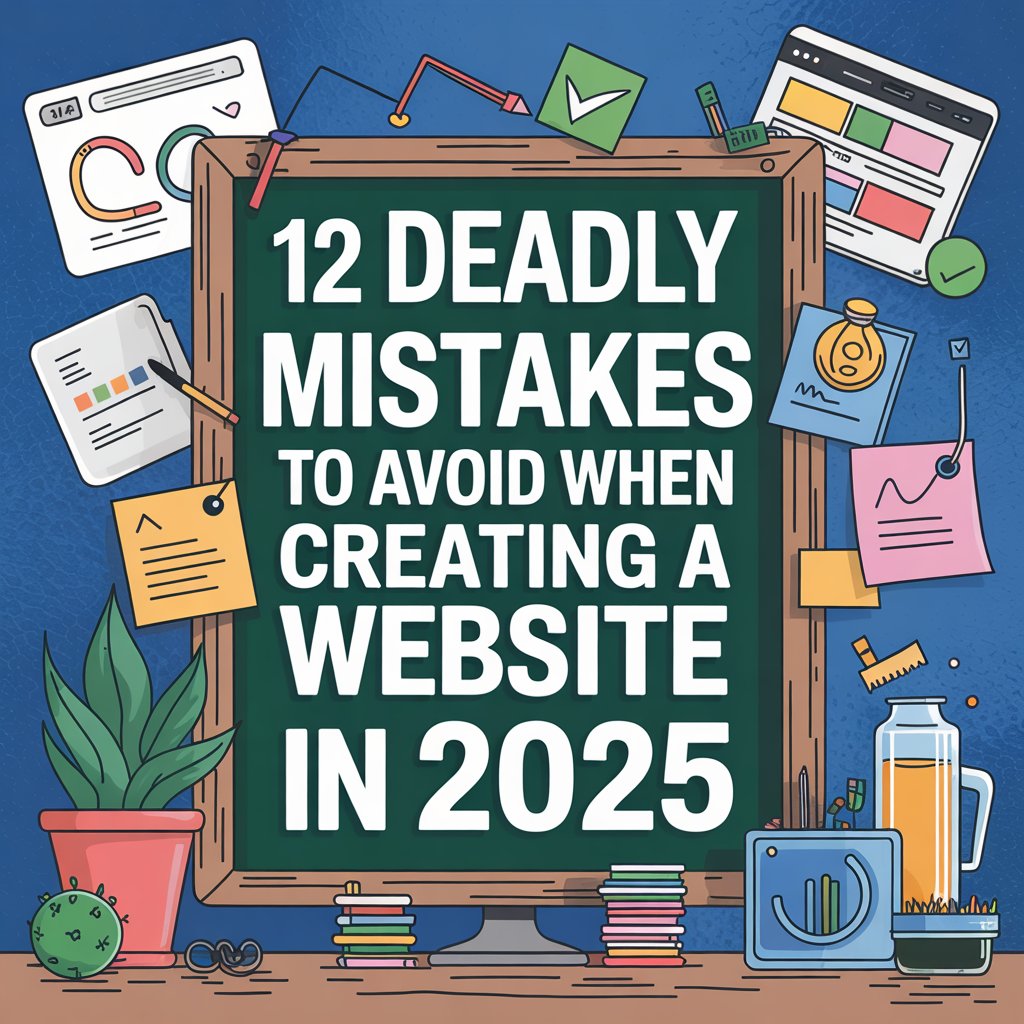Did you know that 53% of mobile visitors will abandon your site if it takes more than 3 seconds to load? Even more shocking, websites loading in just 2.4 seconds see triple the conversion rates compared to their slower counterparts.
These statistics tell us something important about creating a website in 2025. Your business can take a serious hit from what might seem like minor website issues. Mobile devices now account for over 64% of all searches, which means small design flaws can significantly hurt your revenue.
Your website acts as your business’s digital cornerstone. Every choice you make about design, platforms, and technical details shapes how customers see and engage with your brand. A single misstep could lead to fewer sales, weaker credibility, or lower search rankings.
This piece covers the 12 most critical mistakes you need to avoid when creating a website. We’ll guide you past common traps that can harm your online presence. These range from simple planning mistakes to technical issues.
Looking for a custom web development agency that can create the perfect custom website for your business? Let us help.
Creating a Website: Skipping the Planning Phase
Creating a website without proper planning resembles constructing a house without blueprints. Many business owners rush to design and skip the significant first step that determines their site’s success. This mistake ranks among the most expensive website design errors you can make in 2025.
Why skipping planning gives poor results
Teams that bypass planning must make assumptions about their goals, which creates misaligned results. Projects without proper planning often face:
- Development costs rise from multiple revisions.
- Deadlines slip and timelines stretch.
- User experience suffers and visitors get frustrated.
- Search engine performance drops.
- Site purpose and direction become unclear.
The collateral damage goes beyond wasted resources. A poorly planned website fails to support your business goals and confuses visitors while damaging your brand image. Problems like convoluted navigation, inconsistent branding, and technical issues could have been avoided through proper planning.
Time saved by rushing past planning creates more work later.
How to define goals before design starts
Your business’s online success starts with identifying its purpose. The website should build on that original goal. Clear website objectives help shape:
- Your design and development process.
- Content strategy and layout decisions.
- Resource allocation and marketing efforts.
- Search engine optimization approach.
Each goal should follow the SMART framework—Specific, Measurable, Attainable, Relevant, and Timely. This approach ensures you can track and achieve your objectives.
Detailed buyer personas clarify different audience segments’ needs through these discussions. This insight helps create a site that delivers the exceptional experience your visitors expect.
Planning provides a roadmap that directs all subsequent design and development decisions. Clear goals established early transform your website into an effective tool that stimulates business growth rather than just an online placeholder.
Choosing the Wrong Platform
A CMS does more than publish content—it serves as the foundation of your digital presence. Business owners often pick platforms based on what’s cheap or easy right now without thinking about what it all means.
How CMS choice affects flexibility
The right CMS strengthens your ability to adapt as your business grows. Each platform comes with different flexibility levels:
WordPress lets you customize extensively through its ecosystem of 59,000+ plugins and runs on over 40% of websites worldwide. Developers can build almost any feature they want, while non-technical users find it easy to use.
Wix shines at design customization but makes moving to another platform very difficult. Unlike other systems, Wix doesn’t provide you simple ways to export your content. Your business might outgrow what it can do, leaving you stuck.
Squarespace does great with design but restricts full customization. The platform offers beautiful templates that look amazing, though its tools don’t match what others provide.
Drupal gives you “infinite possibilities” through its framework. Complex, custom applications work well here, but you need advanced technical skills.
Look beyond what you need today and think about future growth. Your CMS should expand with your business and support new channels, uses, and connections as technology changes.
The right platform gives you the freedom to grow. Making the wrong choice leads to frustration. Smart businesses focus on flexibility when choosing platforms. This helps avoid rebuilding everything from scratch when needs change.
Ignoring Mobile-First Design
Mobile-friendly websites were once a bonus feature. Those days are gone. Mobile devices tell a big story. They account for over half of all website visits globally. This shift changes how users interact with online content.
Why mobile-first is no longer optional
Mobile-first design creates sites specifically for smaller screens first, then scales up to larger devices. This approach is different from responsive design, which adapts desktop sites to fit mobile screens. A mobile-first website stays responsive, yet a responsive website isn’t always mobile-first.
Google made mobile-first indexing the standard several years ago. The mobile version of your site now determines ranking and indexing. Sites that aren’t mobile-friendly face big penalties in search results, even if their desktop versions do well.
Mobile-first design needs more than layout adjustments. The essentials include:
- Simple interfaces with minimal text and larger fonts.
- Quick load times are optimized for varying connections.
- Touch-friendly navigation with proper sizing.
- Simple forms and clear calls to action.
How mobile design affects SEO and conversions
Poor mobile optimization severely hurts SEO. Google’s switch to mobile-first indexing means your site’s mobile version sets your search ranking. Bad mobile experiences lead to lower visibility, less traffic, and missed business opportunities.
Mobile optimization builds trust. Users see mobile-friendly sites as more professional and reliable. This trust creates higher engagement, repeat visits, and more conversions.
Facts speak clearly: skipping mobile-first design in 2025 goes beyond a simple oversight. This critical mistake directly affects your website’s performance, visibility, and business results.
Overcomplicating the Site Structure
When creating a website, your structure defines how pages connect and how visitors find their way through content. A site without a defined structure becomes just a random collection of pages and posts. This makes it hard for users to find what they need.
Flat vs deep navigation
Site hierarchies usually come in two types: flat and deep. A flat structure has fewer layers (typically 1-3) with more options at each level. Users can reach content with just a few clicks. Deep structures use multiple hierarchical levels (4 or more). Users must go through several subcategories to reach their destination.
Research shows that flat hierarchies generally work better. Content becomes easier to find when it is not hidden under multiple layers. Each extra page load adds about 6 seconds to the user’s time on site. A deep structure could make visitors wait up to 30 seconds to find what they need.
Amazon shows how a flat structure works well even with a large product catalog. They sell millions of items, but their navigation lets customers find products within 2-3 clicks through broad categories and good filtering.
How poor structure confuses users and search engines
A complex structure creates problems for visitors and search engine crawlers. Too many menu options overwhelm users’ decision-making abilities. Sites with clear navigation can boost usability by up to 84%.
Search engines face these same issues. Google uses your site’s structure to figure out content importance and relevance. A poorly organized structure makes it hard for Google to understand each page’s purpose. This can hurt your organic rankings.
Common structural problems include:
- Too many menu options that overwhelm visitors.
- Deep hierarchies that need too many clicks.
- Navigation that changes between sections.
- Confusing labels that puzzle visitors.
- Pages that don’t connect to your main structure
These issues do more than just annoy users. Complex structures lead to higher bounce rates, less engagement, and lost conversions. Visitors leave when they can’t find what they need quickly.
The quickest way to get good results is to keep important pages within three clicks of your homepage. This meets user expectations for quick access and helps search engines crawl your site efficiently.
Neglecting Technical SEO
Technical SEO forms the backbone of web development. Great designs attract attention, but many businesses struggle with the basic tech details. These elements help search engines find, crawl, and index their content. A stunning website becomes invisible online without these fundamentals.
Common technical SEO issues
Crawlability problems stop search engines from reaching your content. Dead links make up 15% of all crawl errors. They create roadblocks that prevent search engines from finding your pages. Websites with well-laid-out sitemaps let search engines crawl up to 6% better. Site owners often mess this up.
Site speed shapes your rankings and user’s experience. Desktop pages load in 2.5 seconds on average, while mobile takes 8.6 seconds. Google ranks site speed as a crucial factor. Slow sites get penalized whatever their content quality.
Mobile optimization issues damage rankings since Google switched to mobile-first indexing. Your mobile site now determines your search position. Technical mobile optimization isn’t a choice—it’s a must.
Structured data helps search engines grasp your content better. Missing this chance means no rich snippets in search results. These snippets can boost click-through rates by a lot.
A solid technical foundation lets your content and design truly shine. Your website stays trapped in a digital black hole without these fixes—pretty to look at but impossible to find.
Using Outdated or Bloated Themes
WordPress website performance depends heavily on theme selection. Many site owners get attracted to visually stunning themes loaded with extra features. They often don’t realize how these choices can slow down their sites and create security risks.
How themes affect speed and security
Speed Effect: Beautiful animations, sliders, and cascading imagery in complex themes need JavaScript to work. This adds to metrics like Cumulative Layout Shift (CLS) and Interaction to Next Paint (INP), which frustrate users. Your site becomes slower with each elaborate feature—even if you don’t use most of them.
Large file sizes come from complex themes that slow down loading times. WordPress theme developers compete intensely, which makes them add more features to stand out. Take Divi as an example—its extensive customization options add substantial weight to loading times.
Security Concerns: Website security problems often stem from outdated themes. Critical security vulnerabilities showed up in more than 50 WordPress themes during 2021. These exposed users to attacks like Cross-Site Scripting (XSS), Remote Code Execution (RCE), and SQL injection.
Security flaws get patched through regular theme updates, but site owners often skip these vital updates. Known vulnerabilities become easy targets for hackers when themes stay outdated. Unused themes can also give hackers backdoor access if left unmanaged.
“Nulled” themes pose the biggest threat as pirated versions of premium themes. These unauthorized copies often hide malicious code, backdoors, or scripts that hackers can exploit. Original developers never send security patches to nulled themes, which makes them even riskier.
Theme selection shapes visitor experience and site security. Clean, lightweight themes perform better than feature-heavy options in all performance metrics. Tests prove that minimal themes like GeneratePress score exceptionally well because of their streamlined file structure.
Forgetting About Accessibility
A quarter of Americans have disabilities, yet 96% of websites fail simple accessibility standards. This exclusion of potential customers creates legal risks as web-related ADA lawsuits continue to rise yearly.
Simple fixes to improve accessibility
Alternative text for images should be your first step. Screen reader users can understand visual content better with this addition. It improves SEO and keeps functionality intact when images fail to load. Your alt text should be descriptive without going overboard.
Your site must work without a mouse. Keyboard-only users need to navigate through websites effectively. You should test this by tabbing through your entire site. Your site needs work if you can’t reach all interactive elements.
Color contrast plays a vital role. The WCAG suggests a contrast ratio of at least 4.5:1 between text and background colors. Users with visual impairments, including 8% of men with color blindness, struggle with poor contrast.
Video captions and audio transcripts make your content available to deaf or hard-of-hearing people. Search engines can index your audio content through transcripts, boosting SEO.
Forms frequently create accessibility hurdles. Use clear field labels and group related fields together. Helpful error messages can guide users in fixing problems.
Accessibility improvements help everyone, not just people with disabilities. Better experiences come from clear navigation, readable text, and well-structured content. Search engines rank accessible websites higher due to improved structure and content.
Modernizing accessibility after launch costs more than building it from the start. Early integration saves money and helps avoid legal trouble.
Not Optimizing for Speed
Page speed can make or break your website’s success today, when users want everything instantly. Slow loading times push visitors away more quickly than almost anything else. That’s why speed optimization should be your top priority when you’re creating a website.
How speed affects bounce rate
Numbers tell the real story—slower pages mean higher bounce rates. Load times that go up from 1 to 3 seconds make visitors 32% more likely to leave. The situation gets worse when pages take 5 seconds to load, as the bounce rate jumps to 90%.
Big media companies have seen this firsthand. The BBC found that they lost 10% of their users for every additional second their pages needed to load. E-commerce sites face even bigger challenges—79% of shoppers who deal with slow sites say they won’t come back to buy again.
Money talks in these situations. Making your website just one second faster can boost mobile conversions by 27%. On the flip side, a two-second delay makes bounce rates shoot up by 103%.
Users just won’t stick around. Research shows that 53% of mobile visitors will leave if a site takes more than three seconds to load. This happens across all industries—users typically lose focus after just 0.3 to 3 seconds.
You can spot speed problems with tools like Google Lighthouse and GTmetrix. These services show exactly what slows down your site and give you practical tips to fix them. Regular performance checks help you catch and fix issues before they hurt your conversion rates.
To sum up, speed optimization isn’t something you can leave for later; it needs to be at the core of your website strategy.
Publishing Without a Content Strategy
Website owners waste resources creating content that doesn’t serve users or business goals. This happens because they don’t have a content strategy. This framework is key. It gives every piece of content a real purpose.
Why content-first design works better
Content-first approach transforms your website’s performance. This methodology places content at the center of your digital efforts. Content experiences need underlying structure to succeed.
Content-first design begins with planning your communication needs before visual elements. Your design will support your brand message this way. Building a website around well-developed content helps everything find its proper place. This prevents major design changes later to fit unexpected content.
The content strategy process has four key phases: planning, creation, maintenance, and removal of old material. Different tools and tactics keep content activities smooth in each phase. Without this approach, content can be hard to understand. Users may leave websites altogether.
A thoughtful content strategy matches your business goals with audience needs. Planning content first helps identify objectives that serve your organization and its users. This creates a cohesive experience that builds credibility.
Failing to Set Up Analytics
Analytics works as your website’s dashboard. It shows how visitors interact with content, their origin points, and which pages make them take action or leave. You’ll end up making design choices based on hunches instead of evidence without this data.
The technical aspects of analytics setup shouldn’t scare you – it’s quite simple. Google Analytics remains the top choice for most sites because it offers detailed tracking for free. You can watch user activity throughout the customer experience, from their first click to final purchase.
What data you need to track
Some metrics matter more than others. Your tracking should focus on measurements that match your business goals.
User behavior metrics should come first, like bounce rate—the percentage of visitors who leave after seeing just one page. This shows if you have content engagement problems or navigation issues. Average engagement time tells you how long visitors stay on specific pages and highlights your best content.
Your traffic sources reveal where visitors come from—search engines, social media, or direct visits. This helps you assess which marketing channels bring your most engaged audience.
Conversion metrics directly boost your revenue. These include conversion rate (visitors who complete desired actions), customer acquisition cost, and customer lifetime value. Website speed matters too—a one-second improvement can boost mobile conversions by 27%.
E-commerce sites need to watch cart abandonment rates and average order values. Content sites should focus on page views per session and top-performing pages.
Good analytics setup changes website management from guesswork to smart decision-making. You can keep improving based on real user behavior rather than assumptions.
Ignoring Security and Maintenance
Website security breaches drain millions from businesses every year. Many creators still treat security as an afterthought. Cyber threats keep evolving. Regular maintenance and security updates are vital to protect sensitive information.
Websites lacking proper security become easy targets for hackers. Research shows that all but one of these hacked WordPress sites had outdated plugins, themes, or core software. This weakness puts your business and user data at risk.
Your website needs regular maintenance to stay healthy. Security updates protect sensitive data and help maintain user trust. Skipping these updates creates weak spots in security. They also cause compatibility issues and slow down your site’s performance.
How to protect user data
HTTPS encryption should protect your entire site. This security protocol keeps all browser-to-website communication encrypted. No one can intercept your data. Use strong, unique passwords with multi-factor authentication to block unauthorized access.
Only collect data you really need. Hackers are less likely to target sites with minimal user data. Use AES-256 encryption for data you must keep. This makes information useless without proper authorization.
Think of security scans as health check-ups for your website. Tools like Wordfence spot threats early. Back up all website files and databases weekly. Quick recovery becomes possible if something goes wrong.
Set clear user roles with different permission levels. Only authorized staff should access sensitive information. Keep detailed access logs of who sees what data. You can quickly spot any suspicious activity.
The latest security patches should protect all your software components—CMS, plugins, themes, and server software. Old, outdated software creates one of the biggest security risks for websites.
Not Testing Before Launch
Website testing before launch often takes a backseat when deadlines loom closer. Research shows that fixing problems after a website goes live becomes 15 times more expensive than addressing them during the design phase. Pre-launch testing isn’t just recommended; it’s a vital step in creating a successful website.
What to test before going live
Functionality testing across multiple devices and browsers should be your top priority. Each browser interprets website code differently, which leads to variations in how your site looks and works.
Your site’s interactive elements need proper verification. Each form submission, button click, and menu interaction requires careful testing to work as planned. The testing should cover:
- Form submissions and error messages
- Navigation menus and drop-downs
- Payment gateways (for e-commerce sites)
- User login and account functionality
Speed testing plays a critical role since slow-loading pages drive up bounce rates. You can spot performance bottlenecks early through testing before they affect actual users.
Common issues caught during testing
Testing before launch reveals problems that could hurt the user experience. Broken links make up 15% of all crawl errors. Teams often miss content, use improper header tags, and forget to change placeholder text.
Mobile responsiveness issues pop up frequently during testing. Most users browse on mobile devices, so your site must look good and work well on smaller screens.
Real users often uncover usability problems during testing. Someone unfamiliar with your site can offer fresh insights into confusing areas. Early usability tests help spot roadblocks that might frustrate visitors and reduce conversions.
Conclusion
Building a successful website needs attention to many moving parts. Small mistakes add up fast and affect your site’s performance, user experience, and results.
Good planning creates the foundation for success. The process starts with choosing the right platform and moves through content strategy. Your CMS choice shapes what you can do later, so you must think about flexibility. Mobile optimization isn’t optional anymore; phones and tablets drive over 63% of all traffic.
The core team must focus on site structure, speed, and security constantly. Users find what they want quickly with clean navigation. Proper security safeguards your business’s and customers’ data. Early testing catches problems and saves money compared to fixing things after launch.
Your site becomes available to millions of potential customers when you make it accessible. Better experiences come from simple changes. Use proper heading structure, include alt text, and ensure keyboard navigation.
Analytics help you measure results and improve based on real information instead of guesses. The best way is to track key metrics. This helps find areas for improvement and growth opportunities.
These 12 critical mistakes can make or break your website’s future. You’ll build a website that meets your business goals and user needs when you put these practices in place today.






